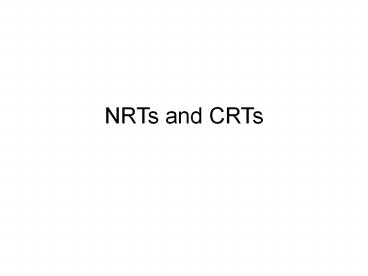NRTs and CRTs - PowerPoint PPT Presentation
Title:
NRTs and CRTs
Description:
NRTs and CRTs Two families of tests Norm-referenced tests (NRT) The relative standing of a student is important (ex. TOEFL, GRE) Students are measured against other ... – PowerPoint PPT presentation
Number of Views:259
Avg rating:3.0/5.0
Title: NRTs and CRTs
1
NRTs and CRTs
2
Two families of tests
- Norm-referenced tests (NRT)
- The relative standing of a student is important
(ex. TOEFL, GRE) - Students are measured against other students
- Criterion-referenced (CRT)
- How well a student meets a set of pre-specified
criteria is important (ex. Exams in content
classes) - Students are measured against a set of criterion
3
What do NRT scores look like?
Imagine that 24 students take a 25-item
proficiency test
We expect most students to be average with some
higher and some lower
4
NRT Humor
5
What do CRT scores look like?
Imagine that 24 students take a 25-item test on
the first day of the semester and then again on
the last day of the semester
We expect most students to bomb the test the
first time (because they dont know the material
yet, and ace the test the second time (because
theyve learned the material over the course of
the semester.
6
NRTs are good for
- Assessing general ability
- Ranking and ordering students
- Discriminating among students
- Gatekeeping
7
Problems with NRTs
- Teaching/testing mismatches
- Lack of instructional sensitivity
- Lack of curricular relevance
- Restriction to normal distribution
- Restriction to items that discriminate
8
CRTs are good for
- Measuring instructional gain
- Determining how well students have mastered
specific content - Studying instructional / institutional
effectiveness
9
Comparison of NRT and CRT
10
Types of tests
- Proficiency
- Placement
- Achievement
- Diagnostic
- Aptitude
- Minimum competency































